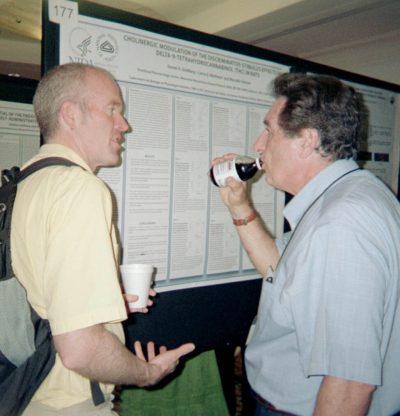Addiction Specialist Alan Budney explains in the new journal Cannabis and Cannabinoid Research, “For a long time, scientists had great difficulty showing in animal experiments that animals would self-administer Cannabis or THC-type compounds… Scientists did finally solve these issues and now have clearly demonstrated Cannabis self-administration and withdrawal in the animal lab.”
We broke the story of this major scientific achievement in O’Shaughnessy’s:
Steven Goldberg (right) in conversation with John McPartland maintains a colony of monkeys in Baltimore, Maryland that have been trained to self-administer THC (by injection). At the 2005 ICRS meeting Goldberg and Zuzana Justinova presented a poster on “The Abuse Potential of the Endocannbinoid Transport Inhibitor AM404: Self-Administration by Squirrel Monkeys.” AM404 is one of the many compounds that corporate- and government-funded scientists have developed in hopes of achieving higher cannabinoid levels by means other than the illegal herb. Goldberg’s monkeys liked AM404 enough to self-administer it, which means, in NIDA’s terms, that AM404 is a drug with potential for abuse. After all their effort to create an alternative to smoked marijuana, the drug companies will have to run their products by Goldberg’s monkeys to assess their abuse potential!
The Goldberg-Justinova poster concluded “AM404 functioned as an effective reinforcer (comparable to THC, anadamide and cocaine under identical conditions) in non-human primates under a fixed-ratio schedule of drug injection. Our findings suggest that medications which promote the actions of endocannabinoids throughout the brain by inhibiting their membrane transport have a potential for abuse. It remains to be seen whether medications such as FAAH inhibitors, which augment CB1 signaling only in certain regions of the nervous system, would be self-administered in a similar manner.”
Your correspondent had always heard that monkeys could not be trained to self-administer THC. When I asked Goldberg to explain his achievement, he said other researchers had used “Old World monkeys,” whereas he used squirrel monkeys from South America. But the real key to his success, he added, was the very low doses with which he rewarded the monkeys. This made sense —most of the primates I know prefer a slight alteration of mood to getting knocked-out-loaded. It also resonated with an ICRS talk on neuroprotection by Italian investigators who found that a synthetic cannabinoid was beneficial only at the lowest concentrations tested, and detrimental at high concentrations. —Fred Gardner (O’S, Autumn 2005)





